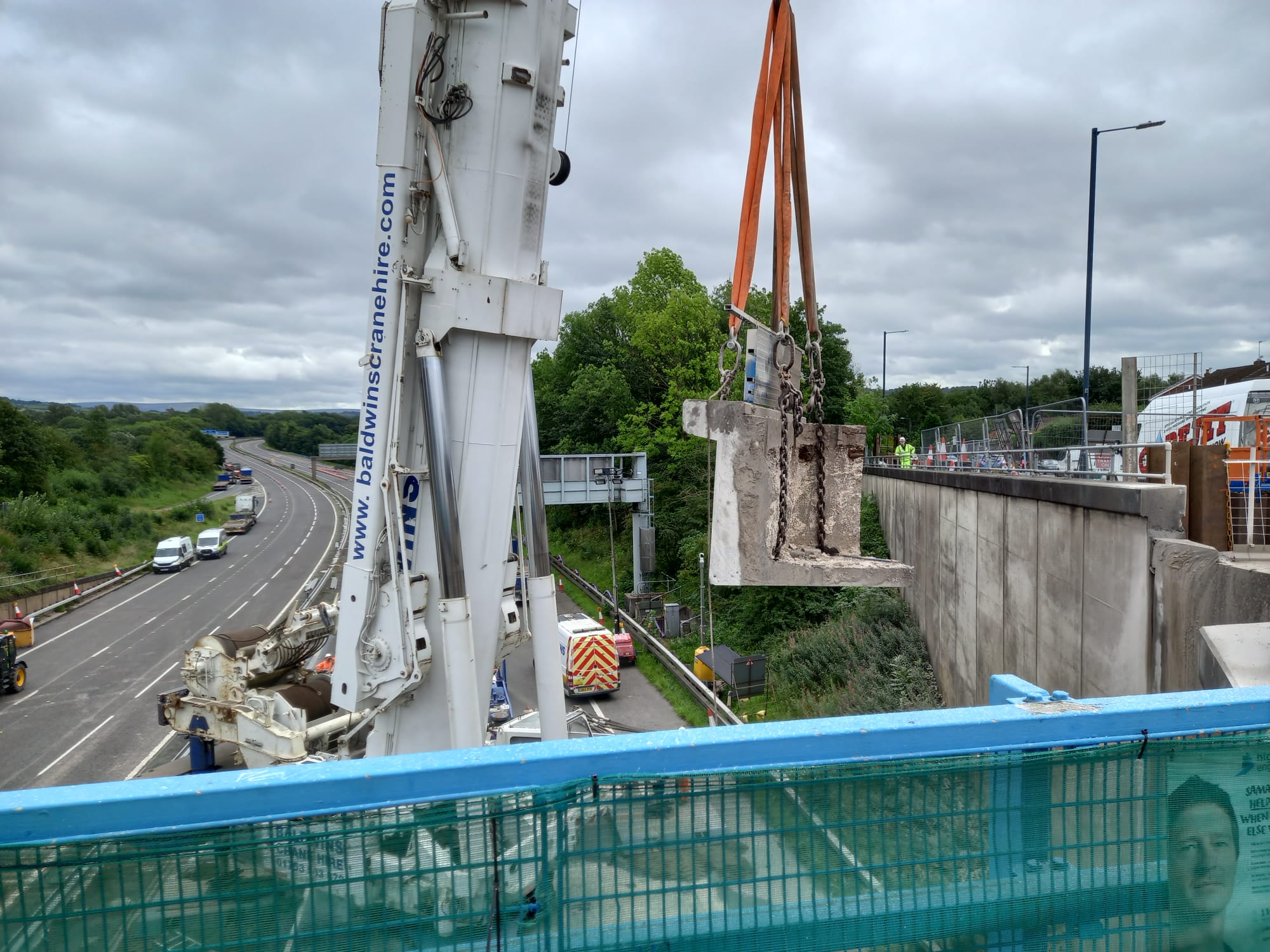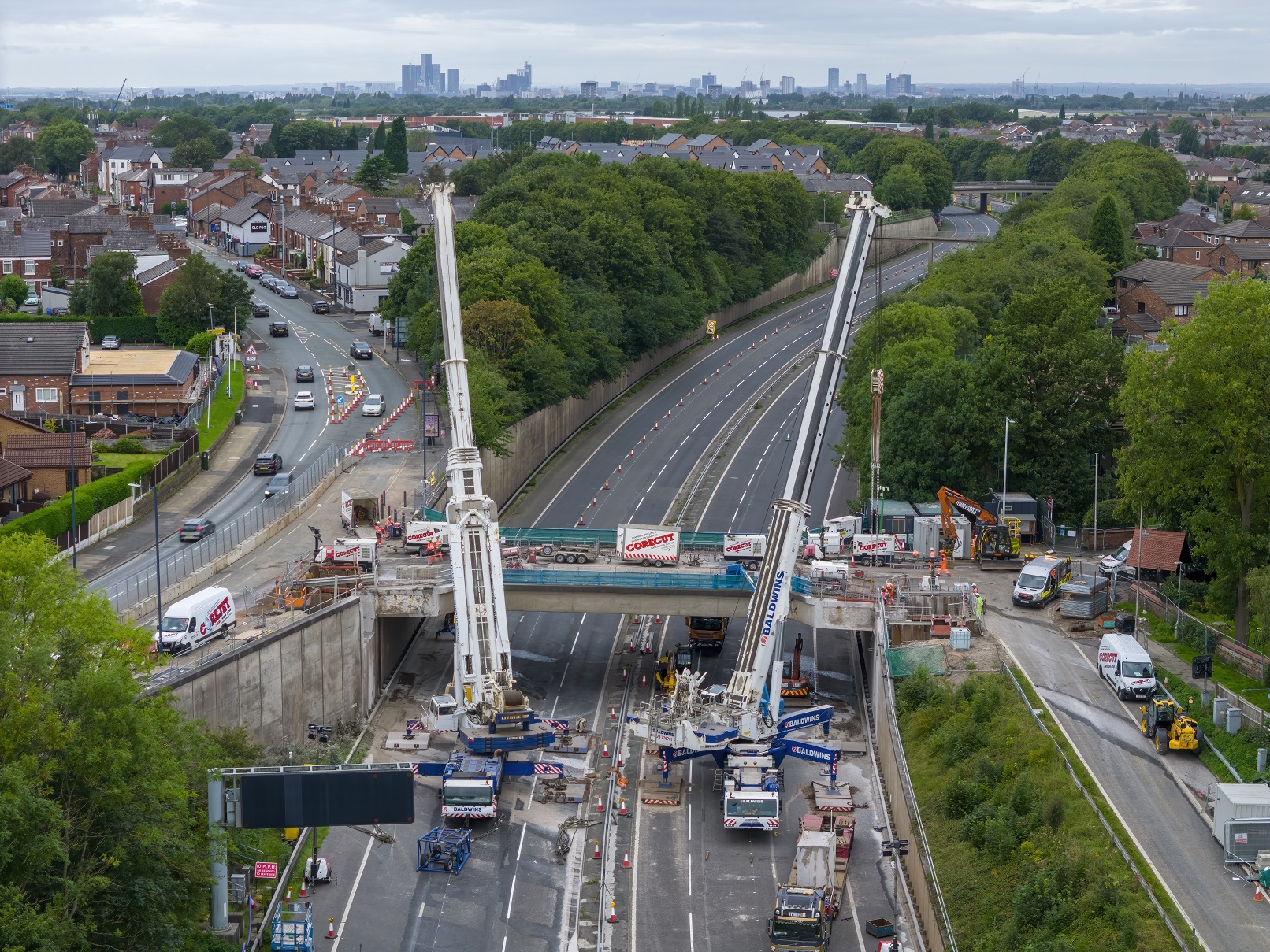M67 St Anne’s Bridge
-
 Location: Denton
Location: Denton
-
 Sector: Highways
Sector: Highways
-
 Division: Infrastructure
Division: Infrastructure
This case study focuses on the first phase of the St. Anne’s Road bridge over M67 J2 project, which involved demolishing and completely replacing the bridge.
The bridge was closed to traffic on 10 January 2023, and in preparation for the construction, United Utilities and Cadent Gas diverted the clean water and gas to ensure uninterrupted services. This case study solely deals with phase 1, which commenced in June 2023, involving the eastern side of the bridge and the remodelling of supporting walls to accommodate a new section for transporting vital services such as water mains across the M67.
At a glance...

£5.9m
Project value

August 2023
Completion date

National Highways
Client
Demolition
The bridge phase 1 demolition comprised several stages to allow the demolition of the eastern bridge wedges.
The north and south eastern wedges were removed in two pieces.
The demolition technique used was wire cutting and the works included some pre-works that were completed before the weekend demolition to minimise the weight of the lifting operations during the M67 weekend closure.
These pre-works included the removal of the top concrete slabs on the north and south deck voids, the removal of the void formers (polystyrene) and the execution of all the cores needed for the weekend wire cutting and lifting operations.
Pre-works
The demolition process began with the core holes to allow the removal of the void’s top concrete slabs by wire and saw cutting techniques. The void former used to construct the bridge was polystyrene and was removed using a vac-exc.
The cores that allow the concrete deck lifting operations were halfmoon shaped. The purpose of this was to ensure the chains do not move or slide during the lifting operations.
The horizontal cores that allowed the abutment block lifting works were two overlap 150mm diameter cores and it was important to check that the lifting chains and hooks would fit in them.
The entire process of wire and saw cutting and preparation for the demolition took three weeks and was completed in time for the weekend.
Weekend demolition
To complete the phase 1 demolition, the M67 was closed from 18-21 August 2023. The works started with the wire cutting plant set up and rigging the cranes (500Tm). The wire cuts started on north and south abutments and the wedges were cut and lifted safely onto the wagons. This process took one day. Once the wedges were cut and lifted, the wire cut started to cut the abutments and they were lifted with the cranes onto the wagons.
The weekend closure allowed us to work around the clock through day and night shifts in order to meet the deadline. Through effective and collaborative management, the phase 1 demolition was successfully completed on Sunday 21 August 2023 at 3pm, ahead of schedule.
Collaborative management
Collaborative management played a crucial role in the project’s overall success. All key stakeholders, including the client, designers, subcontractors, local authorities (Tameside and Transport for Greater Manchester) and other Construction Works Framework (CWF) contractors, participated in weekly progress meetings and planning sessions. This collaborative approach facilitated effective planning and streamlined operations.
Value engineering
Value engineering played a significant role in reducing the project’s cost and timescale. By reassessing the design, it was identified that the initial three lifts needed to remove the abutments could be reduced to two lifts, decreasing the cutting works duration by six hours per abutment.
A large part of the pre-works done before the weekend demolition were initially planned to be done during the weekend demolition itself. Removing these activities from the weekend scope reduced the amount of works to be done under the road closure and provided a time allowance in case there were any issues during the weekend activities.
Conclusion
This project demonstrates the effectiveness of collaborative management, as well as the value of engineering principles.
By embracing open communication and collaboration among stakeholders, effective planning, streamlined operations, and problem solving were achieved.
Additionally, the implementation of value engineering significantly reduced the works duration while ensuring a high quality outcome. This case study serves as a testament to successful project management and highlights the benefits of a collaborative and innovative approach to construction projects.






